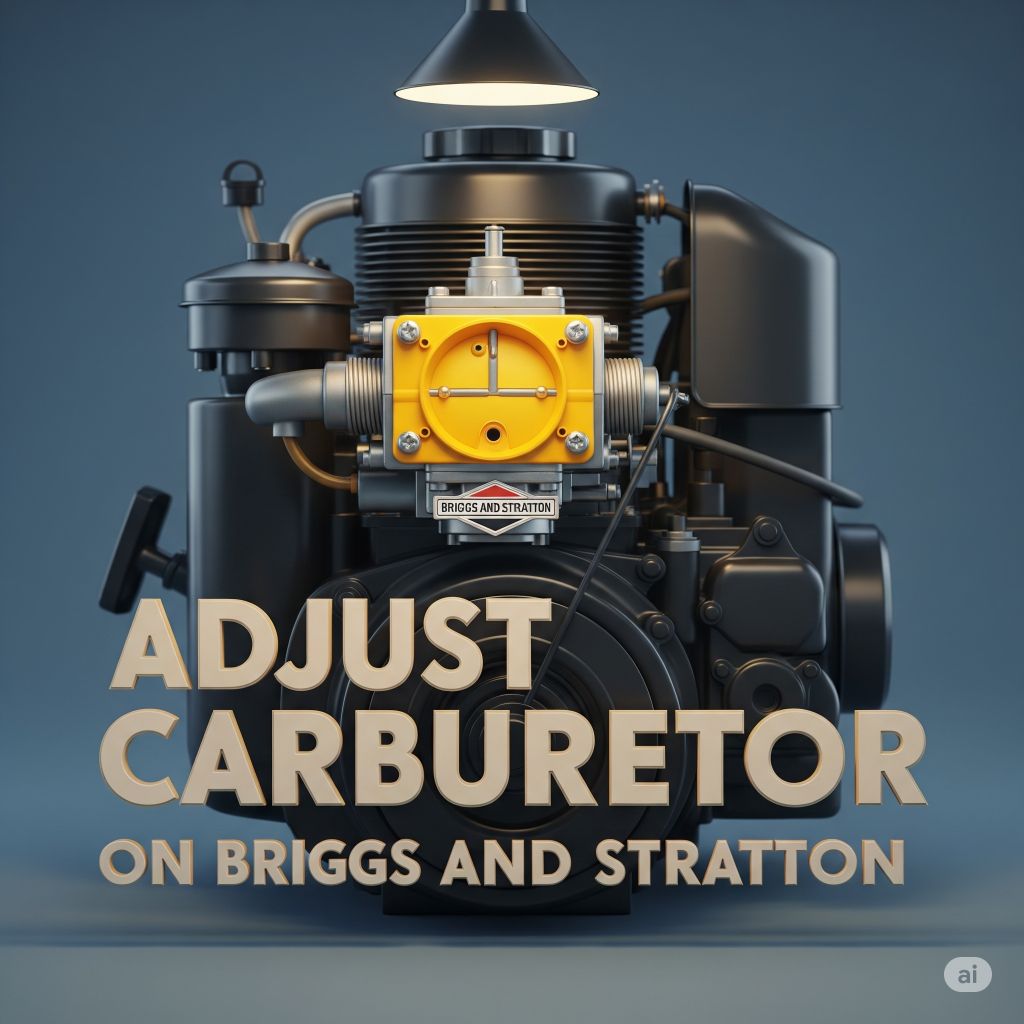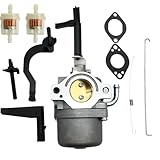
Adjusting the carburetor on your Briggs and Stratton engine can help ensure optimal performance, fuel efficiency, and engine longevity. Here’s a comprehensive guide on how to adjust the carburetor, including common adjustment points, tools needed, and step-by-step instructions.
Understanding the Carburetor
The carburetor is responsible for mixing air and fuel in the appropriate ratio for combustion. A properly adjusted carburetor helps your engine start easier, run smoother, and consume fuel efficiently. Most Briggs and Stratton engines have similar carburetor designs, making this adjustment process relatively consistent across models.
Common Symptoms Indicating Carburetor Adjustments
- Difficulty starting the engine
- Rough idling
- Surging or hesitation during acceleration
- Excessive fuel consumption
- Backfiring or misfiring during operation
Tools Required
- Screwdriver (flathead and Phillips)
- Wrench or socket set
- Pliers
- Clean cloth
- Tachometer (optional)
- Fuel stabilizer (if necessary)
Step-by-Step Guide to Adjusting the Carburetor
Step 1: Safety First
- Turn Off the Engine:
Ensure the engine is turned off, and the spark plug wire is disconnected to prevent accidental starts. - Allow Engine to Cool:
Give the engine sufficient time to cool down if it has been running to avoid burns.
Step 2: Locate the Carburetor
- Access the Engine Compartment:
Depending on your Briggs and Stratton model, you might need to remove covers or shields to reach the carburetor. - Identify Adjustment Screws:
There are typically two screws on the carburetor—often labeled as:
- Idle Adjustment Screw: Controls the fuel mixture at idle (usually found near the bottom of the carburetor).
- Main Adjustment Screw (or Mixture Adjustment Screw): Regulates the fuel mixture during higher RPM operation (usually on the side).
Step 3: Adjust the Idle Mixture
- Start the Engine:
With the spark plug wire disconnected, ensure you can access the carburetor, then reconnect the wire and start the engine. - Warm Up the Engine:
Allow the engine to warm to its normal operating temperature. This usually takes about 5-10 minutes. - Set the Idle Speed:
A tachometer can help you check idle RPM. Adjust the throttle to reach the manufacturer-recommended idle speed (typically around 1500-2000 RPM). - Adjust the Idle Mixture Screw:
Turn the idle mixture screw slowly:
- Clockwise: Decreases fuel (makes the mixture leaner).
- Counterclockwise: Increases fuel (makes the mixture richer).
- Slowly turn the screw until the engine runs smoothly. Listen for a change in engine sound. Ideally, you want the highest smooth idle.
Step 4: Adjust the Main Mixture Screw
- Increase Engine RPM:
After adjusting the idle, increase the throttle to approximately 3,000 RPM. - Adjust the Main Mixture Screw:
Similar to the idle adjustment:
- Turn the main screw clockwise to make the mixture leaner.
- Turn counterclockwise to enrich the mixture.
- Adjust until the engine runs smoothly without sputtering or backfiring.
Step 5: Fine-Tuning (If Necessary)
- Test the Engine:
After both adjustments, let the engine run at varying speeds (idle to full throttle) to ensure smooth operation without hesitation or stalling. - Revisit Adjustments:
If necessary, make small further adjustments while observing the engine’s performance.
Step 6: Final Checks
- Check for Leaks:
Look for any fuel leaks around the carburetor and ensure all screws are tight. - Reconnect Spark Plug Wire:
Ensure the spark plug wire is tightly reconnected. - Test Run:
Start the engine one last time and take it for a test run. Pay attention to starting, idling, and acceleration.
Step 7: Clean and Maintain
- Regular Maintenance:
Consider adding fuel stabilizer to your fuel if the engine will not be used often, and clean the air filter to maintain engine performance. - Check Filters:
Regularly inspect and replace fuel and air filters as needed to prevent carburetor issues in the future.
Briggs And Stratton Carburetor Error Codes
Common Briggs and Stratton Carburetor Error Codes
Here’s a list of common error codes associated with Briggs and Stratton carburetors, along with explanations and troubleshooting tips.
1. Error Code 1: Engine Won’t Start
- Meaning: This error may indicate a blockage in the carburetor or fuel system.
- Possible Causes:
- Clogged fuel filter
- Dirty or blocked carburetor jets
- Empty or contaminated fuel tank
- Faulty spark plug
- Solution:
- Check and replace the fuel filter if necessary.
- Clean the carburetor jets using carburetor cleaner and a small brush.
- Ensure the fuel tank has fresh gasoline and that it is free of contaminants.
- Inspect and replace the spark plug if it shows wear or damage.
2. Error Code 2: Rough Idle or Stalling
- Meaning: This error indicates an improper air-fuel mixture or an issue with engine idle speed.
- Possible Causes:
- Incorrect adjustment of idle mixture screw
- Vacuum leaks in the intake manifold
- Dirty air filter
- Malfunctioning governor system
- Solution:
- Adjust the idle mixture screw to achieve a smooth idle.
- Inspect and replace any damaged gaskets in the intake system to prevent vacuum leaks.
- Clean or replace the air filter as needed.
- Test and adjust the governor mechanism to ensure proper engine speed control.
3. Error Code 3: Engine Surging or Hesitation
- Meaning: This means the engine is struggling to maintain consistent RPMs.
- Possible Causes:
- Inconsistent fuel delivery to the carburetor
- Blocked fuel lines or vents
- Incorrect float height in the carburetor
- Solution:
- Inspect the fuel lines for clogs and replace if necessary.
- Ensure that fuel vents are clear and not blocked, which can disrupt fuel flow.
- Check and adjust the float height according to the specifications in the owner’s manual.
4. Error Code 4: High Fuel Consumption
- Meaning: This indicates that the engine is using more fuel than normal.
- Possible Causes:
- Rich air-fuel mixture due to wrong adjustments
- Faulty carburetor diaphragm
- Sticking float causing overflow
- Solution:
- Adjust the carburetor’s mixture screws to lean out the fuel delivery.
- Inspect and replace the diaphragm if it appears damaged.
- Check the float mechanism for proper operation and adjust to eliminate overflow conditions.
5. Error Code 5: Carburetor Leak
- Meaning: Leads to fuel leakage, visible signs may include fuel pooling under the engine.
- Possible Causes:
- Damaged gasket or O-ring
- Loose connections
- Cracked or damaged carburetor body
- Solution:
- Inspect gaskets and O-rings, replacing any that appear worn or damaged.
- Tighten all connections securely.
- If the carburetor body is cracked, it may need to be replaced.
General Troubleshooting Tips
- Refer to the Owner’s Manual: Always start by consulting the owner’s manual for specifications related to your specific engine model.
- Routine Maintenance: Regular maintenance, including cleaning and adjustments, can prevent many common carburetor issues.
- Use Quality Fuel: Always use fresh and high-quality fuel to minimize the risk of contamination or degradation.
- Check for Software Updates (if applicable): Some newer engines may have electronic components or systems that require software updates.
- New Oem Carburetor
- Genuine Briggs & Stratton Part
- Replaces Old Briggs # 796109
- No Assembly Required
- REPLACEMENT PART NUMBER: This 799584 carburetor replaces part number 799584 592361 594057 594058 594529 engine carburetor. Fit for 163CC 6.75-7.25HP engine.
- COMPATIBLE MODEL: Lawnmower carburetor compatible with TB110 TB200 103M02 550EX 625EX 675EX 725EXI 09P702-0001-B1 09P702-0007-F1 09P702-0010-F1 09P702-0024-F1 09P702-0047-F1 09P702-0055-F1 09P702-0075-F1 09P702-0098-F1 09P702-0104-F1 09P702-0115-F1 09P702-0116-F1 09P702-0119-F1 and most other 09P000 models.
- HIGH PERFORMANCE: 799584 Lawn mower carburetor selects high quality alloy material to effectively solve the problems of leakage, lack of power, black smoke from the exhaust pipe, etc. to ensure it can be used for a long time.
- EASY TO INSTALL: The push mower carburetor is simple and easy to use, and installation videos are easy to find on the web and take only 5-10 minutes to install.
- BUY WITH CONFIDENCE: If you have any problem when using 799584 Carburetor, please feel free to contact our after-sales team through Amazon, we provide 24 hours 100% satisfaction service.
- Fitment: Carburetor carb kit Compatible with Briggs And Stratton Model 030467 Generator
- Package contains: 1 X Carburetor kit as picture shows
- The highest quality replacement Carburetor. Made of High Quality & Durable Material.Tested & certified to meet or exceed OEM quality standards.
- Secure Installation: It takes you few minutes only to put it on your engine, watch a video on YouTube is gonna help.
- Please check our photos and make sure the part shown looks identical to your stock one
- Carburetor Compatible with Briggs Stratton 498170 799872 694202 693909 692648 499617 799868 497586 498254 497314 497347 497586 497410 790821 498254 497347 497314,lawn mower parts carburetor
- Fits Most 122000 Model Engines, compatible Model: 120XXX / 121XXX / 122XXX / 12EXXX / 12TXXX With Primer Type System.Compatible with BS 14111 carburetor,
- Carburetor for Craftsman 6.5hp Snapper Ninja 6.75hp Engines.Carburetor for Stens 50-657, Stens 520-966; carburetor for 4-7 hp engines with no choke; carburetor for Snapper Ninja 6.75hp Engine;
- Carburetor Compatible with Briggs & Stratton 124T02 124T05 124T07 126M02, Compatible with BS 129700 129800 123H00 123J00 124H00 125H00 12G700 12G800 12J700 12J800 12J900 12L800 12U800 12V800 12C700 12C800 12D800 4 Cycle Small Engine. Carburetor for Toro 16401 20716 20712 20713 20714 Walk Behind Mower,
- Pre-adjusted before shipping, no extra adjustment needed.Comes with 1 X 799868 carburetor,1 X 795259 Air Cleaner Primer Base ,all parts shown in the pictures.
- 【Compatible】 Perfect for Briggs & Stratton 696065 697422 110402 110412 215369 Tiller Engine Carb.
- 【Replace Part Number】 110402-0206-E1 110412-0211-E1.
- 【Package Includes】 1x 696065 Carburetor, 2x Gaskets, 1x 491588S Flat Air Filter, 1x Spark Plug.
- 【High Quality 696065 Carburetor】 Made of high quality materials, This is aftermarket replacement Parts, Not is original Parts,All of the Brands We mentioned,Just for compatibility with these Brands, Exact equivalent part meets the original manufacturer’s specifications and features.
- 【After-Sales Service】 Buy with confidence. We offer free returns and exchanges, if you have any questions, please feel free to contact us by email.
Conclusion
Adjusting the carburetor on your Briggs and Stratton engine can drastically enhance its performance and efficiency. With routine maintenance and careful adjustments, you’ll ensure your engine operates optimally for years to come. It’s essential to follow these steps methodically and consult the owner’s manual for your specific model for best results. If issues persist beyond carburetor tuning, consider contacting a professional or authorized service center for further assistance.

I’m David man behind Lawn Mowerly; I’ve been dealing with lawnmowers and Tractors with my father since I was a kid. I know every make and model and what each one is capable of and love helping people find the perfect equipment for their needs.





